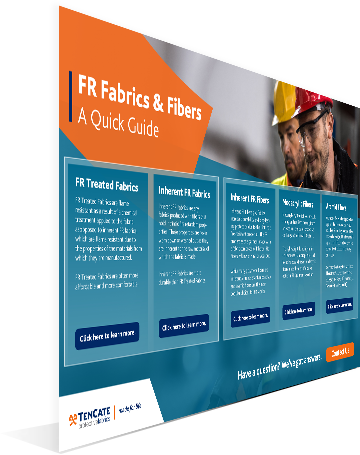Flame resistant (FR) fabrics are foundational to industrial safety, protecting workers against the significant risks of fire-related hazards. Safety managers and procurement specialists must understand the different mechanisms that make fabrics flame resistant to make informed decisions in FR garment selection. We’re delving into the technical aspects, benefits, and applications of both types of FR fabrics, referencing products and technologies from TenCate Protective Fabrics.
Understanding Flame Resistant Technologies
FR fabrics can be classified into two main categories: inherent FR and treated FR. Each type has unique characteristics and advantages, making them suitable for different applications.
Inherent Flame Resistant Fabrics
Inherent FR fabrics are made from fibers that possess flame resistant properties by their very nature. These fabrics provide consistent protection throughout their lifespan, as the flame resistance is an intrinsic quality of the fiber itself.
Key Features:
- Permanent Protection: The flame resistant properties of the fibers are built into their molecular structure, ensuring consistent protection for the entirety of the garment’s service life.
- Durability: Inherent FR fibers, such as those used in TenCate Protective Fabrics’ Tecasafe® Plus, stand up to extensive wear and repeated laundering.
- Comfort and Breathability: Advanced inherent FR fabrics offer improved comfort and breathability through innovative blends using inherent FR fibers with other fibers noted for their comfort and moisture-wicking benefits, making them suitable for long-term wear in various industrial environments.
Treated Flame Resistant Fabrics
Treated FR fabrics are made by chemically treating fabric to impart flame resistant properties. The chemical treatment fully penetrates the fibers and is bonded throughout the entire fabric, rendering the fabric flame retardant for the lifetime of the garment.
Key Features:
- Cost-Effective: Treated FR fabrics are often more economical initially, making them an attractive option for budget-conscious safety programs and in industries such as steel and metalworking where molten metal splashes occur.
- Versatility: These fabrics can be produced from a wide range of base materials, allowing for various fabric weights and textures.
- Chemical Treatments: The flame-resistant properties are achieved through treatments such as phosphorus-based compounds or other flame-retardant chemicals.

Download our FR Fabrics & Fibers Quick Guide
DownloadDetailed Comparison
1. Flame Resistance Origin
- Inherent FR: These fabrics offer permanent flame resistance through the intrinsic nature of the inherent FR fibers used in their manufacturing, ensuring long-term protection without the need for additional treatment to be flame resistant.
- Treated FR: The flame resistant properties of treated fabrics are added through a chemical treatment of the fibers, which is infused into the fibers themselves, imparting them with flame resistant qualities for the lifetime of the garment. Similarly to inherent FR, treated FR fabrics are robust to stand up to frequent and/or industrial laundering.
2. Comfort and Wearability
- Inherent FR: Designed with user comfort in mind, these fabrics often feature superior breathability and moisture management. Tecasafe® One is an example of an inherently FR fabric that combines comfort with high-performance protection.
- Treated FR Fabrics: The chemistry of FR treatments for treated FR fabrics works with cellulosic fibers, like cotton or lyocell. While it is possible to offer some variation in fabric weights and weaves in treated FR fabrics, they tend to be heavier in weight than what is possible with inherent FR fabrics.
3. Cost and Replacement Considerations:
- Inherent FR: The initial investment in quality inherent FR fabrics is typically higher. However, their long-term durability and consistent protection often result in lower total cost of ownership than less durable garments that need to be replaced more frequently. Industries that require workers to wear FR every day but that have a relatively low risk of that FR being put to the test by an incident, such as in chemical plants or utilities, often choose inherent FR solutions because the cost of the garment is spread out over a longer service life.
- Treated FR: These fabrics offer a lower upfront cost, making them accessible for companies in industries that have a higher replacement frequency required. Welders, for example, are frequently exposed to a lot of sparks on their garments and will have to replace their gear more regularly. Inherent FR would be costlier to replace than treated FR in this instance.
4. Performance in Different Environments:
- Inherent FR: Suitable for environments requiring continuous flame resistance over long periods of time. Industries like oil and gas, electrical utilities, and manufacturing benefit greatly from the durability of inherent flame-resistance fabrics.
- Treated FR: Effective in scenarios where cost is a significant factor. Ideal for industries with varying levels of fire hazards. Effective for environments facing frequent sparks and molten splash.
Choosing Inherent or Treated FR
Choosing between inherent and treated FR fabrics involves assessing the specific needs of your industry, the working environment, and economic considerations. Inherent FR fabrics like Tecasafe® Plus and Tecasafe® One provide permanent protection and superior comfort, making them ideal for long-term safety investments. Treated FR fabrics offer an economical initial solution that is suitable for environments where the protective garments are subjected to frequent sparks and/or molten splash and require more regular replacement.
For detailed information on FR fabric technologies and to find the best solution for your industrial safety needs, try out our fabric selector tool. Or get expert guidance from a TenCate Protective Fabrics expert who can help you make an informed decision that ensures optimal protection and economic efficiency:






.png?width=399&name=Untitled%20design%20(40).png)

